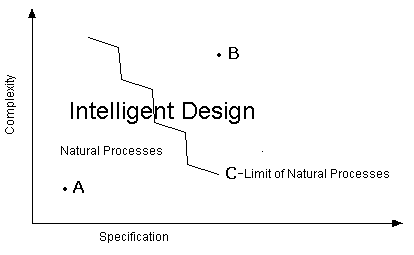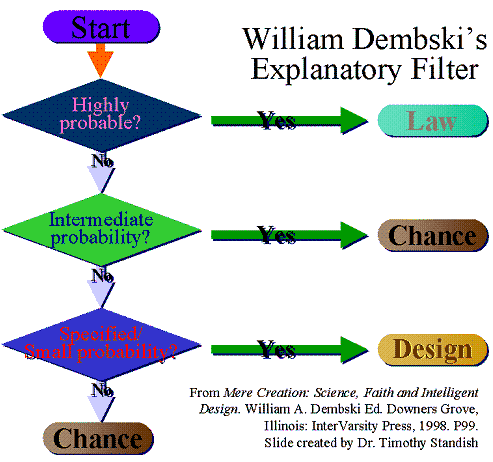| The Short Answer: A false positive is when you say something is true, but it really isn't. Right now, science probably have to worry about ID producing false negative (saying something ID isn't designed, when it really is) because science already operates under the presumption that nothing is designed anyway, so "false negatives" will not change how science currently works. But false positives could pose a problem for science--if we begin to infer design when we really shouldn't. However, false positives are always a problem in many scientific theories--where we are making claims based upon inferences. If the evidence points to design, we should infer it. We can be careful and use the explanatory filter to only detect design in certain circumstances where the evidence seems to warrant design. If we do infer design, that doesn't stop us from still investigating natural causes.
|
The Long Answer:
Fears over intelligent design often come from the claim that intelligent design would mean "giving up" on evolution, or the end of scientific investigation. Biologist Rudolph Raff objects to design theory saying, "as the influence of the intelligent designer grows
the relationships between the phenomena and explanations becomes increasingly arbitrary
[until] one reaches a point where all biological features are 'special creations' and other explanations become unnecessary." (Raff, Rudolf A., "The creationist abuse of evo-devo." Evol Dev, 3(6): 373-374 (2001)). In this case, Raff is not necessarily afraid that we are mixing science with religion, but that design is a sort of "science stopper." In fact, design theorist William Dembski sees Raff's arguments as typifying the reasons for the exclusion of design from science:
"As the influence of the intelligent designer grows
the relationships between the phenomena and explanations becomes increasingly arbitrary
[until] one reaches a point where all biological features are 'special creations' and other explanations become unnecessary." (Raff, Rudolf A., "The creationist abuse of evo-devo." Evol Dev, 3(6): 373-374 (2001)
Raff wants design and teleology out of science because he is afraid that it will "take over science". Yet intelligent design theorists are sensitive to these concerns and want to keep intelligent design theory within its proper bounds. In fact, design theorist William Dembski would see Raff's arguments as typifying the reasons for the exclusion of design from science:
"What has kept design outside the scientific mainstream these last 130 years is the absence of precise methods for distinguishing intelligently caused objects from unintelligently caused ones. For design to be a fruitful scientific theory, scientists have to be sure they can reliably determine whether something is designed. Johannes Kepler, for instance, thought the craters on the moon were intelligently designed by moon dwellers. We now know the craters were formed naturally. This fear of falsely attributing something to design only to have it overturned later has prevented design from entering science proper." (Dembsk, Mere Creation)
Dembski understands Raff's sort of concerns. What would solve Raff's problem, however, would be a rigorous criteria which allows scientists to know when to detect and infer design, and when not to. If such a method could be found, then what is best explained naturally remains explained naturally, while what is best explained through design, becomes explained through design. As Dembski subsequently says, "[w]ith precise methods for discriminating intelligently from unintelligently caused objects, scientists are now able to avoid Kepler's mistake." (Dembsk in Mere Creation) In calling what Kepler did a "mistake," Dembski shows that he doesn't want intelligent design theory to take over biology or science. Intelligent design wants design to be inferred where the evidence warrants--no more, and no less. Follow the evidence wherever it leads!
That being said, how does intelligent design theory detect design? There are many positive predictions of design (i.e. that designed objects will contain large amounts of specified complexity). To safely infer design only when it is warranted, ID theorist William Dembski proposes to follow an "explanatory filter" whereby only those things which were designed are detected as designed:

Point A represents something probably made by natural processes. Point B represents something made by intelligent design. Curve C represents the upper limit to what natural processes can produce. Inferences made from both points A and B are based upon probabilities. The question is where to draw the line so that we don't infer false positives for design. One way to avoid false positives is to safely draw the line far to the right, so that we would have more false negatives than false positives. Dembski uses this strategy when he only infers design if the odds of it happening naturally are below the universal probability bound (i.e. things that can happen in the history of the universe).
|
How then do we detect design reliably?
We can reliably detect design because of the criteria in Dembski's criterion that design requires complex and specified information. Natural processes simply cannot produce this high level of information. Therefore, we dont mistakenly infer design when it was really evolution. Detecting design is thus a statistical argument.
We know this because we understand that when intelligent agents act, they use choice. An essay by William Dembksi lays out in detail how we can understand the products of intelligent design by examining how designers work:
To see why CSI [complex-specified information] is a reliable indicator of design, we need to examine the nature of intelligent causation. The principal characteristic of intelligent causation is directed contingency, or what we call choice. Whenever an intelligent cause acts, it chooses from a range of competing possibilities. This is true not just of humans, but of animals as well as extra-terrestrial intelligences. A rat navigating a maze must choose whether to go right or left at various points in the maze. When SETI (Search for Extra-Terrestrial Intelligence) researchers attempt to discover intelligence in the extra-terrestrial radio transmissions they are monitoring, they assume an extra-terrestrial intelligence could have chosen any number of possible radio transmissions, and then attempt to match the transmissions they observe with certain patterns as opposed to others (patterns that presumably are markers of intelligence). Whenever a human being utters meaningful speech, a choice is made from a range of possible sound-combinations that might have been uttered. Intelligent causation always entails discrimination, choosing certain things, ruling out others. Given this characterization of intelligent causes, the crucial question is how to recognize their operation. Intelligent causes act by making a choice.
CSI is a reliable indicator of design because its recognition coincides with how we recognize intelligent causation generally. In general, to recognize intelligent causation we must establish that one from a range of competing possibilities was actualized, determine which possibilities were excluded, and then specify the possibility that was actualized. What's more, the competing possibilities that were excluded must be live possibilities, sufficiently numerous so that specifying the possibility that was actualized cannot be attributed to chance. In terms of probability, this means that the possibility that was specified is highly improbable. In terms of complexity, this means that the possibility that was specified is highly complex. All the elements in the general scheme for recognizing intelligent causation (i.e., Actualization-Exclusion-Specification) find their counterpart in complex specified information-CSI. CSI pinpoints what we need to be looking for when we detect design. (Intelligent Design as a Theory of Information, by William Dembski at "http://www.arn.org/docs/dembski/wd_idtheory.htm")
In summary, Dembski notes that intelligent agents can choose from one of many competing possibilities. If the choice made is unlikely to occur and sufficiently complex, then we can attribute that choice to design. This comes from our understanding of how intelligent agents operate--not from a negative argument against evolution. In The Design Inference, Dembski lays out a three-part "user-friendly" explanatory filter which we can use to detect intelligent design:

This explanatory filter recognizes that there are three causes for things: chance, law and design. The premise behind the filter is the positive prediction of design that designers tend to build complex things with low probability that correspond to a specified pattern. In biology, this could be an irreducibly complex structure which fulfills some biological function. This filter helps ensure that we detect design only when it is warranted. If something is high probability, we may ascribe it to a law. If something is intermediate probability, we may ascribe it to chance. But if it is specified and low probability, then this is the tell-tale sign that we are dealing with something that is designed. In these high information-situations, intelligent design theorist Stephen C. Meyer also emphasizes why intelligent design is the right explanation:
"Experience teaches that information-rich systems
invariable result from intelligent causes, not naturalistic ones. Yet origin-of-life biology has artificially limited its explanatory search to the naturalistic nodes of causation
chance and necessity. Finding the best explanation, however, requires invoking causes that have the power to produce the effect in question. When it comes to information, we know of only one such cause. For this reason, the biology of the information age now requires a new science of design.
(Stephen C. Meyer, Mere Creation, pg. 140).
"Indeed, in all cases where we know the causal origin of 'high information content,' experience has shown that intelligent design played a causal role."
(Stephen C. Meyer, DNA and Other Designs)
"Intelligent design provides a sufficient causal explanation for the origin of large amounts of information, since we have considerable experience of intelligent agents generating informational configurations of matter."
(Meyer S. C. et. al., "The Cambrian Explosion: Biology's Big Bang," in Darwinism, Design, and Public Education, edited by J. A. Campbell and S. C. Meyer (Michigan State University Press, 2003)
Intelligent design is thus a cause sufficient to produce the high levels of information, i.e. irreducible complexity, found in biology. This is a reliable indicator of design, and thus even if there are occasional false positives, we are justified in inferring design because it meets positive predictions of design. To avoid false positives, we could set the standard of design very high. Plus, even when we infer design, we can still investigate natural causes to see if those bear more fruit in the future.

